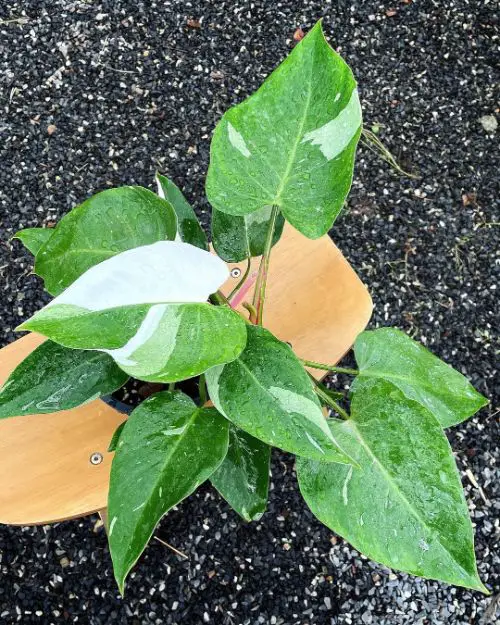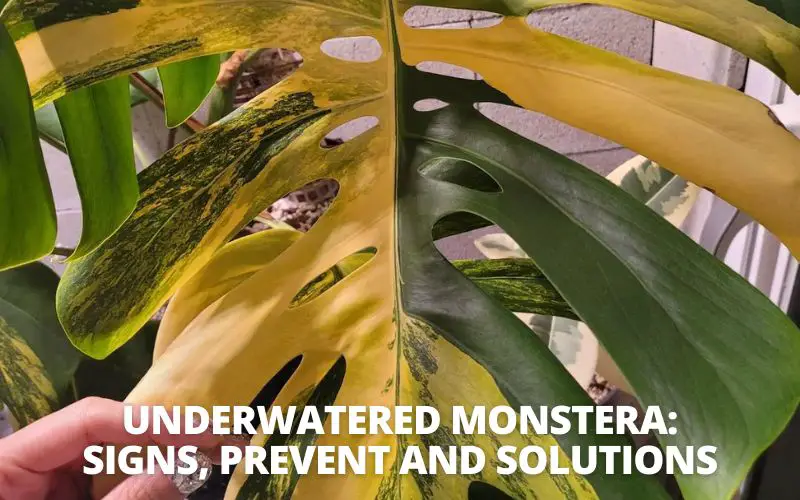Underwatered Monstera is a common issue for those who own the plant. This can often lead to the demise of your beloved Monstera, so it’s essential to take some preventative steps to avoid this. In this guide, we will provide how to tell if monstera needs water and save your plant.
Signs your monstera needs water (Underwatered monstera)
One of the most common questions I get as a plant parent is how to tell if my Monstera needs water. There are a few different ways to tell, and the best method may vary depending on the stage of growth your monstera is in. And here are the 8 main signs that make monstera underwatering
Sign #1: Leaves are wilting or drooping
If the leaves start to look pale or yellow, drooping, or if the fenestrations begin to close up, it is a sign that the plant is not getting enough water. Another way to tell if your Monstera needs water is to touch the soil.
If it feels dry to the touch, it is time to give your plant a drink. Monsteras typically need to be watered once every week or two, but during periods of hot weather, they may need to be watered more frequently. Be sure to always check the soil before watering to avoid overwatering, which can cause root rot.
Sign #2: Leaves are dry and/or brittle
Another sign of an underwatered Monstera is dry or brittle leaves. The leaves will feel papery to the touch, and may even start to shed if the problem isn’t corrected quickly. If you notice these symptoms, increase watering immediately and make sure the plant is getting enough humidity.
You may also need to adjust your watering schedule so that the plant isn’t allowed to dry out completely between waterings. deepening your watering sessions or adding more frequent ones may be necessary.
Sign #3: Stems are weak
If the stems of your Monstera are weak, it means they’re not getting enough support from the roots. This is usually a result of too little water. The stem will appear thin and spindly, and the leaves may droop or fall off entirely. watering your Monstera, be sure to keep an eye on these signs so you can act quickly! With a little TLC, you can bring your plant back to health in no time.
Sign #4: Slow growth
One of the more subtle signs of an Underwatered Monstera is slow growth. If your monstera is in a sunny location and you frequently fertilize it, pay closer attention to your soil to see how quickly it is drying up and whether you need to water it more or sooner.
Sign #5: Yellowing leaves
If the leaves of your Monstera start to turn yellow, it’s another sign that the plant needs more water. Other issues can also cause yellowing, so rule those out before assuming dehydration is the problem.
Sign #6: Curling leaves
If you notice that your monstera’s leaves are curling, it may be a sign that the plant is not getting enough water. This can also be a sign of low humidity, so make sure that the plant is not near a heating or AC vent. If the soil seems to retain moisture well, you may need to set up a humidifier before watering the plant more. If the soil is compacted or dry, however, underwatering may be the cause.
If you suspect your monstera needs more water, check the soil before watering the plant. Signs of underwatering include wilting leaves, dry soil, and yellowing leaves. If you see any of these signs, increase the amount of water you give your monstera and check the soil regularly to ensure that the plant is getting enough moisture.
Sign #7: Flower buds falling off
If your Monstera is starting to bud but the buds are falling off before they bloom, it could be a sign of dehydration.
Another potential reason for flower buds falling off your Monstera is too much fertilizer. If you’ve been fertilizing your plant regularly, it’s possible that you’re giving it too much food.
An overdose of fertilizer can cause the buds to fall off, so if you think this might be the problem, cut back on the amount of fertilizer you’re using. Finally, extreme temperatures can also cause flower buds to fall off. If it’s been unusually hot or cold where you live, this could be the culprit.
Sign #8:Dry Soil
One of the easiest ways to tell if your Monstera needs water is to check the soil. If it’s dry, give your plant a good watering. You can stick your finger in the soil to check, or use a moisture meter. We recommend XLUX Soil Moisture Meter which is being used by many people at amazon. You can check the price below. If the soil is too wet, ensure drainage and allow the plant to dry out before watering again.
How much water do Monsteras need?
Monsteras need a lot of water, especially when they’re actively growing. During the growing season (spring and summer), you should water your Monstera every one to two weeks. Ensure the soil is dry before watering, and always allow the plant to drain thoroughly. In the winter, Monsteras need less water since they’re dormant. Once every month should be sufficient.
When it comes to Underwatered Monstera, the best way to save your plant is by giving it a deep soak. Make sure the water reaches the roots and allow the plant to drain thoroughly before putting it back in its pot. Water your monstera when the top few inches of soil are dry – typically every one to two weeks.

What kind of water should use for your Monstera?
If you have access to rainwater, this is the best type of water for keeping your monstera healthy. It will ensure that their soil stays within an appropriate pH range and also helps prevent acid-alkaline soils from occurring which can be harmful over time if not corrected quickly enough by adding base ingredients like lime or fertilizer with vitamin c amongst other things!
Use caution if the municipal water in your area contains excessive levels of fluoride or chloramines. As an alternative, leaving the tap water in an open container overnight would be beneficial. This might aid in the breakdown of some of these chemicals.
You may also like: Why are my plant leaves Dripping Water? Here’s The Answer
Prevention tips for keeping your Monstera healthy and thriving
- Water your Monstera when the top few inches of soil are dry – typically every one to two weeks
- Make sure the water reaches the roots and allow the plant to drain thoroughly before putting it back in its pot
- In the winter, Monsteras need less water since they’re dormant. Once every month should be sufficient
- Place your Monstera in a spot where it will receive bright, indirect light. Avoid direct sunlight, which can scorch the leaves
- Fertilize your Monstera every two to three months during the growing season (spring and summer). Use a balanced fertilizer or one that’s high in nitrogen
Thanks for reading! Underwatered monsteras are a common issue for plant owners but by following this guide, you will know how to tell if your monstera needs water and save your plant!


